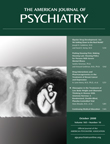A review of randomized, placebo-controlled treatment trials for anorexia nervosa reveals a dismal state of affairs. Very few of these trials exist, and those that do have inadequate sample numbers with high dropout rates
(1) . Bissada et al., who conducted the olanzapine treatment trial in anorexia nervosa patients published in this issue of the
Journal (2), should be commended for completing a modest preliminary study. The difficulty of recruitment in this 13-week study, which occurred over a period of 5 years, is similar to that in other treatment trials in anorexia nervosa. Of the 139 eligible patients in this study, 45% refused day hospital treatment. Of the 76 patients who agreed to day hospital treatment, 55% declined drug treatment. After random assignment, 18% of participants dropped out of the study—a surprisingly low amount, most likely due to the short period of treatment (10 weeks). Because of this high treatment refusal rate, the authors acknowledge their results apply only to anorexia nervosa patients who are willing to accept pharmacological and intensive day treatments that enhance weight gain. In other words, a minority of the anorexia nervosa population.
In another multisite 1-year treatment study comparing medication alone with cognitive-behavioral therapy (CBT) and their combination, the overall dropout rate was 46%. Treatment acceptance, defined as staying in treatment 5 weeks, occurred in 73% of subjects but was present in only 56% of those assigned to medication alone. In the other two groups, acceptance rate was differentiated by high and low obsessive preoccupation scores. The only predictor of treatment completion was high self-esteem
(3) .
The two studies described here were conducted with adult subjects. Dropout rates in randomized, controlled trials of psychological treatments for adults with anorexia nervosa average around 40%
(4) . Meaningful assessment of outcome and data analysis depend on the maintenance of sufficient participants in random conditions. In contrast to studies of adults, randomized, controlled trials for anorexia nervosa family studies have dropout rates of 10% to 20%
(5) . It is reasonable to assume that the parental authority to compel legally underage patients to participate in treatment is a significant factor in the lower dropout rates. In consideration of the serious difficulties with recruitment and dropout for randomized, controlled trials in adult anorexia nervosa patients, it does not seem logical to recommend more multisite randomized, placebo-controlled trials for this population. The result would only be the study of a larger number of a biased sample. This means the prevention of chronic anorexia nervosa and its associated high morbidity and mortality should focus on early diagnosis and adequate treatment of the underage anorexia nervosa patient.
Olanzapine, with its side effect profile of weight gain and antiobsessive and antidepressant properties, which is noted by Bissada et al. in this issue, is a promising drug to study for the treatment of severely emaciated and obsessional anorexia nervosa patients. Olanzapine acts on multiple neurotransmitter systems including dopamine, serotonin, histamine, and a
1 -adrenergic receptors
(6) . This drug may have cholinergic agonist activity due to its blockade of M
2, 5-HT
3, and 5-HT
6 receptors (unpublished 1999 paper of Meltzer and O’Laughlin). It is likely that the complex constellation of anorexia nervosa symptoms is due to the interactions of multiple impairments in brain neurocircuitry. Robust evidence exists for alterations of function of the serotonin and dopaminergic systems in anorexia nervosa
(7) . The exact mechanisms whereby olanzapine may facilitate weight gain and reduce symptoms of obsessions in anorexia nervosa patients are unknown. However, it is reassuring to have these drug effects demonstrated in a carefully conducted randomized, controlled trial
(2) to provide some preliminary evidence-based treatment data for a select group of anorexia nervosa patients.
Many questions need to be answered regarding olanzapine treatment of anorexia nervosa. When is the best time for treatment and what are the criteria for discontinuing the drug? Should this drug be restricted for the treatment of severely emaciated and obsessional anorexia nervosa patients only? How can we motivate seriously ill anorexia nervosa patients to voluntarily take this medication? Acceptance of medication was significantly improved with the addition of psychotherapy in one anorexia nervosa treatment study
(3) . Thus, it is possible that psychological treatment enhanced compliance with olanzapine treatment of anorexia nervosa in the trial by Bissada et al.
It is unlikely that predictably effective treatment for anorexia nervosa will be available until we decipher the reinforcing neurobiological mechanisms sustaining the disorder.

